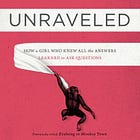I’m a Guest at RavenCon
There are 5-10 different programmed events happening every single hour of this weekend — including Sunday morning, which is downright uncouth.

But then, what should you expect from scavengers? Even really smart scavengers?
In honor of this sci-fi weekend, two links to a favorite story, originally published in Future Tense, which I mentioned last week being part of the tiny but hopefully growing policy / prose industrial complex.
Hi Robot. It’s Bey. I can’t be your admin anymore. I’m really sorry because it was nice to know you. Unfortunately the CDC lost its funding. I work at Amazon Health now, but we aren’t allowed to network with open drones like you. I don’t think anyone is going to shut you down or collect you, so I guess you can do whatever you want. If anything really bad happens, text me here on my private number. I hope the language acquisition algorithm is still helping!
Here in non-mountainous Greensboro, we regularly hear the caw-caw of American Crows and less often the nasal croaking of a Fish Crow, but no Ravens.
My favorite Crow happens to be a lawyer. Sadly, he’s not coming along this weekend. That man can rock a cravat.
Bolts, Not Brains
Righter Tighter, Lefter Looser might or might not apply to politics, but it definitely does not apply to neuroscience. Ever since French medic Paul Broca presented his first aphasic patient in 1861, it’s been known that language resides in the left hemisphere of the brain.1 That’s the grammar and vocabulary. The music of speech — the rhythm, the pitch and stress and tone that we use only for emphasis in English — resides at least as much on the right. That one very important insight has been generalized in dozens of different ways, most of which are just retreads of the Logos / Pathos, Apollo / Dionysus dichotomies.
I recently stumbled across this post by a very well-known philosopher (just not, until now, by me)
referencing a book about how the two halves of the brain have two different ways of thinking, and we’ve leaned too far into the left-hemisphere mode.
Medical doctor Leonard Shlain made a similar argument in a much more fun way almost thirty years ago, using out-of-date anthropology and centuries’ worth of cherry-picked art history in The Alphabet Versus the Goddess. Here’s an example from his timeline.
3,000,000 - 2,900,000 years ago
Hominids differentiate away from other primates by becoming meat-eaters instead of vegetarians.
Extended childhood's of hominid babies require prolonged attention from hominid mothers.
Males of the species predominately engage in hunting and killing.
Females primarily engage in nurturing and gathering.
Hominids become the first species of social predators in which the females do not participate in hunting and killing.
200,000 - 90,000 years ago
Language develops.
Homo Sapiens differentiate away from hominids.
Language requires complete rewiring of human brains.
Over 90% of language modules placed in the left hemisphere of right handed humans who comprise 92% of the population.
Split Brain phenomenon becomes highly exaggerated only in humans.
Most hunting and killing strategies placed in left hemisphere.
Most nurturing and gathering strategies placed in the right side.
It’s an arresting, tragicomic narrative about how literacy ruined all our lives, with a hopeful twist at the end, as the image-based Internet arrives to rebalance our brains. Kind of like Dianetics in that way, though I liked and continue to like Shlain’s book a lot better.
Less fun but equally compelling as a story is Jill Bolte-Taylor’s more personal account of her left-hemisphere stroke. It’s one of the more popular TED talks of all time, with over 30 million views.
So this is not a new idea.
But I Digress
The main point of the philosopher McGilchrist’s post and the book chapter it’s based on is that biologists are hung up on old mechanical models of the processes of life, as an example of being captured by left-hemisphere ways of thinking.
As David Bohm commented in the 1960s, it is an odd fact that, just when physics was moving away from mechanism, biology and psychology were moving closer to it. ‘If the trend continues’, he wrote, ‘scientists will be regarding living and intelligent beings as mechanical, while they suppose that inanimate matter is too complex and subtle to fit into the limited categories of mechanism.’[9] He was not mistaken.
He leads up to this with
The problem is not just that biology has not availed itself of the insights of quantum physics. It’s that its dogged adherence to the Newtonian mechanistic model persists in the teeth of the evidence of its incompatibility with the phenomena it is trying to explain. It is an egregious instance, I would suggest, of the sort of thing we have seen before when the left hemisphere insists that its re-presentations provide an adequate and complete account of reality – that a porcupine is a monkey because that’s what the theory tells us.
I don’t think that’s wrong, necessarily, but I would argue that the problem is not simply one of Thomas Kuhn’s cycles of scientific revolution being overdue. It is a broader cultural problem.
A big part of the reason that freshman biology classes stick with biochemistry is that most biologists do not enjoy arguing religion with nonmajors.
Physicists have been able to set their own agenda for over a hundred years. Yes, there’s a subset of creationists who maintain that the Big Bang did not happen, and the Earth is only 6,000 years old, but they are not much more influential than the Flat Earthers.
It might be different in Britain where McGilchrist lives now, but here in the US, anti-evolution creationists have not given up the fight against mechanistic biology in the same way that they have given in to physics. The Scopes Trial was a hundred years ago, and to this day, millions of dollars are spent passing laws against the teaching of evolution (and more urgently climate change).
Initially, our literature review revealed four phases of the anti-science education movement in the United States. First, from 1920 to 1968, the effort focused on prohibiting the teaching of evolution using censorship (Matzke 2010). Second, from 1968 to 1987, the movement demanded that creation science get equal emphasis in science classrooms using rebranding and balanced treatment as tactics (Bleckmann 2006; Matzke 2010; Moore 1975). Third, from 1987 to 2005, the effort demanded that intelligent design be taught as a competing scientific theory using the tactics of rebranding and textbook disclaimers (Matzke 2010; Rich 2012). Fourth, around 2005, anti-evolution and anti-climate change education efforts merged and advocated for “teaching the controversy” using academic freedom as a tactic. This research shows that, from 2005 to 2017, academic freedom continued to dominate as the primary anti-science education state legislative tactic. However, since 2017, anti-indoctrination has become the preferred tactic (Figures 4 and 6). Thus, we are now in a new, fifth phase of the anti-science education movement in the United States. [emphasis mine]
Imagine if physicists had to waste their time in court defending thermodynamics.2 Or from a presidential task force.

We all know that when we as humans are challenged, we tend to double down. Some people enjoy arguing.3 Some professionals have even made careers out of it — Jerry Coyne, Richard Dawkins, etc. Others I have known personally tend to borrow the legislative tactic inside their own private classrooms and simply outlaw questions about religion.
This is a science class. We are talking about science, not religion.
I am not one of those people. When I was at the community college, I had a lot of evangelical students. I was raised in a fundamentalist family / community, and I did not find their views as threatening as many of my colleagues did and do. I could discuss (and even argue on rare occasions) without getting flooded by adrenaline. I didn’t do it during class; I would say, “Come by my office hours and we can spend as much time on this as you want.” Students (many of them not even my students) really appreciated the effort.4 5
People enjoy arguing more from their own expertise, and there are a lot of biologists who’ve never read even the little bits of the Bible that I have. So when even an uninformed novice starts quoting scripture to them as evidence, the biologists’ eyes glaze over in very much the same way that students’ eyes do when they see a PowerPoint slide about the citric acid cycle. Biologists understandably want to avoid those uncomfortable interactions.
Does this avoidance get internalized? Do biologists avoid even thinking about the most basic assumptions of the mechanized model? Maybe so, but it’s also true (and maybe more important) that out in the real world of hospitals, medical devices, and pharmaceutical companies, mechanism is still the way to make money. Kuhn’s crisis is building, or brewing, or whatever metaphor you prefer, but I don’t think it’s ready to boil over just yet.
Unless society collapses, of course. Then all bets are off.
with some exceptions, like some left-handers, or people who get left-hemisphere damage at a young age and re-train the right hemisphere.
This mini-controversy is not at the same level.
https://www.yahoo.com/news/college-student-accidentally-broke-laws-123000543.html
My old buddy Hager being one of them. Here’s a podcast interview I did with him in the early 2010s, when the Internet was mostly a machine for arguing about religion and not yet a machine for arguing about literally every single aspect of reality.
That experience was one of the main reasons that a few years later I started the VSI: Variation Selection Inheritance podcast that is archived at the link above. The other being that NSF paid me to do it.






Michelle Chuang asks an LLM about evolution.
https://storylablogs.substack.com/p/gpt-basic-its-not-just-what-you-ask
"To see the ways in which we are, as individuals, not just 'connected' but precipitate as aggregates, in fields of constellated data, prompts a figure-ground reversal in which selves no longer hold their primacy as ground truth of our being, but show up last as we make inferences and draw stories from unbroken and inseparable experience.
Something fundamental changes when we shift to seeing 'human' and 'non-human' as two stable patterns of recursive self-perception emerging from a single fabric of unfolding possibility: we find the opportunity to question what we’re trying to achieve, to notice the ungrounded and conditional reality of narrative, to operate on our own 'source code' and adjust our goals accordingly."
https://michaelgarfield.substack.com/p/h-01